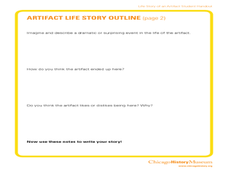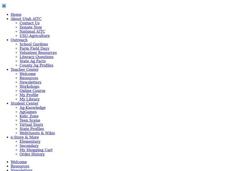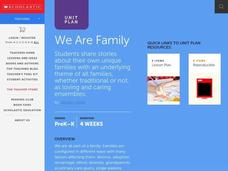Curated OER
Radical Raptors
Students study the lifestyles and habitats of raptors that live in Minnesota. They play games associated with their study.
Curated OER
Kepler and his Laws
Students examine Kepler's Laws. They confirm Kepler's 3rd law by comparing orbital periods and mean distances for all major planets and study conic sections, qualitatively.
Curated OER
Life Story of an Artifact
Students write about an artifact that they are studying. In this artifacts lesson plan, students analyze details of the artifact and answer short answer questions about it.
Curated OER
Food From Around the World
Students identify foods from around the world. In this multicultural lesson, students use Internet resources to research a specific country and the foods which are popular. Students collect a single recipe to combine with recipes from...
Curated OER
Disease and Nutrition
Students study disease and explore how it can be avoided or treated with simple solutions. In this investigative lesson students create a food chart for two weeks for themselves to track and be sure they are getting all the nutrients...
Curated OER
Vary Your Veggies and Focus on Fruits
Third graders study a healthy diet. For this healthy diet lesson, 3rd graders investigate the nutritional value of fruits and vegetables. Students compare a healthy diet to their personal diet.
Curated OER
Foods and Nutrition
Students study nutrition, healthy choices for food, and ways to prepare food. They review the Food Guide Pyramid and play Nutriend Tic Tac Know to select healthy foods. As a group they make pretzels, Mystery Muffins, soda, and play the...
Curated OER
A Creole Cinderella
Pupils engage in shared verbal and written reflections about ethnic traditions. They study fairy tales of the Caribbean and the repeating patterns or themes used in folktales and fairy tales. They discuss similarities and differences...
Curated OER
The Five Food Groups - Introduction to Nutrition
Students study the five food groups as an introduction to nutrition. In this nutrition instructional activity, students learn about which foods belong in each of the five food groups and they determine the need to eat a healthy diet....
Curated OER
Nutrition and Body Image
Students study nutrition and how to maintain a healthy diet. In this adolescent nutrition instructional activity students complete several activities that allow them to see different nutrition scenarios.
Curated OER
Conventions Self-Check Sheet
Fifth graders study conventions in writing. In this grammar instructional activity, 5th graders listen to samples with appropriate conventions and samples without appropriate grammar and determine which are appropriate. Students...
Curated OER
Thinking About Shopping and Spending
Students list and discuss recent commercials they have viewed. They identify advantages and disadvantages of the advertised items, and write about the effects of advertising, planned spending and spontaneous spending.
Curated OER
Redistributing Utah's Tax Resources: Burdens and Benefits
Students divide into three groups to investigate the use of community resources. The groups are given a budget and decide which services are most important by conducting discussions. They put the arguments for the spending in writing for...
Curated OER
Getting the Most Nutrition from Your Food
Healthy eating is a habit that one can never start too early. Learners in grades five through seven, work through a series of activities and informational reading to understand how to make good food choices. You'll find a full...
Curated OER
The Prairie Climate
Ninth graders research the average temperature and precipitation of a prairie region to determine the type of climate it is, and how it differs from other biomes. They examine the types of adaptions animals have made to live in the...
Curated OER
Giants Stalk the High Street
Students explore consumerism in Great Britain. In this current events lesson plan, students visit selected websites to determine how shopping habits have changed in Britain throughout the years. They also evaluate changes in market...
Curated OER
Virtual Connections
Students use prior knowledge to develop a survey on their peers' habits and preferences regarding video games and online gaming. They examine the social aspect of online gaming by discussing "Where Warriors and Ogres Lock Arms Instead of...
Curated OER
Comparing the Food Choices and Body Image of 15-Year-Olds Around the World
Students interpret data regarding food choices and the perceived body image of youth in the world. In this personal health lesson, students compare food consumption patterns in Canada with other countries. Students also compare lifestyle...
Curated OER
We Are Family
Students participate in a class discussion about their family structures. Students also discuss the family diversity of their peers and others in the world. They investigate family habits, family history, values and traditions their...
Curated OER
Random Acts of Kindness
Students make a bookmark. In this community lesson, students review the meaning of caring. They discuss how doing small acts of kindness can affect a community, and they make a bookmark to remind them to do kind things for others.
Curated OER
Group Alignment
Middle schoolers discuss proper ways to work in a group. In this character education lesson, students identify the vocabulary words "inclusion" and "exclusion" and create a list of ways to respect others in a group setting.
Curated OER
Character Education: Caring
Pupils create a bookmark with reminders of simple acts of kindness. In this character education lesson, students participate in a mini-lesson that serves as a great introduction to a service project. Pupils first brainstorm ways to show...
Curated OER
The ABC's of Artifacts
Students create their own ABC book about artifacts. In this artifact lesson, students read ABC History Mystery and review the artifacts pictured in the book. They create their own ABC book with each student working on a letter.
Curated OER
Conflict Resolution
Students engage in learning about conflict resolution and practice using these skills. They take notes on steps and procedures to solving differences. In addition, students practice using these skills in a classroom activity.
























